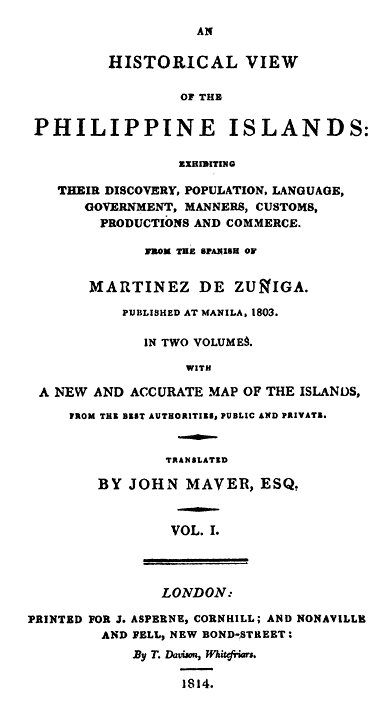An Historical View of the PhilippineIslands.

HISTORICAL VIEW
OF THE
PHILIPPINE ISLANDS:
THEIR DISCOVERY, POPULATION, LANGUAGE,
GOVERNMENT, MANNERS, CUSTOMS,
PRODUCTIONS AND COMMERCE.
IN TWO VOLUMES.
WITH
A NEW AND ACCURATE MAP OF THE ISLANDS,
FROM THE BEST AUTHORITIES, PUBLIC AND PRIVATE.
LONDON:
PRINTED FOR J. ASPERNE, CORNHILL; AND NONAVILLE AND FELL, NEWBOND-STREET:
By T. Davison, Whitefriars.
1814.
[v]
INTRODUCTION.
The original, of which the following translation isoffered to the English reader, is, probably, the only copy which hasyet reached this country. Whether the chance which threw it in the wayof the translator may be deemed fortunate or otherwise must be left tothe decision of the candid public; but it appeared to him that theinformation it contains respecting a Spanish colony, the mostinteresting of any other to a British subject, supplies thatdesideratum so much wanted in our language;—a correct viewdown to a very late period of the Spanish establishments in thePhilippines.
The position of these islands, and, indeed, that of the easternArchipelago generally, whether considered in a political or commercialpoint of view, is sufficiently important. They form the entrepôtof Europe, India, China, the immensely extended regions of SpanishAmerica, the north-western coasts of the new, and [vi]north-eastern coasts of the old world; and inthe storms which at present convulse the political atmosphere ofEurope, as well as that of both the Americas, it is not easy even toconjecture what may be their fate.
The productions of these islands are various, and of a value andimportance unquestionably high. In the hands of an industriouspopulation, and under a fostering government, there is scarcely anyvegetable substance which, by slender exertion, they may not be made toyield, whilst the choicest treasures of the mineral kingdom, lodgedbeneath their irregular surface, minister largely to the cupidity, andfurnish materials for the more enterprising labours of man.
Gold is in abundance; iron, steel, copper, lead, pitch and tar,hemp, cotton, indigo, sugar, cocoa, pepper, betel, cowries,tortoiseshell, mother of pearl and pearls, hides, coyar, tobacco, cornand rice excellent and abundant, with a variety of other productions,contribute to the wants of commerce; while in this enumeration will befound all the articles which, with the aid of t